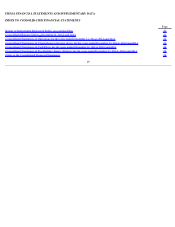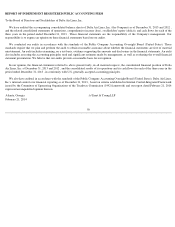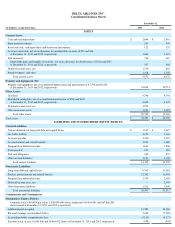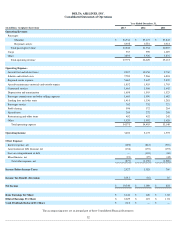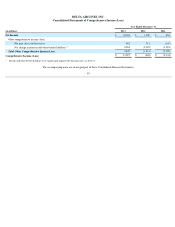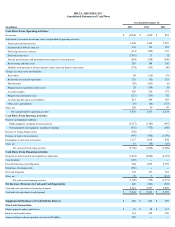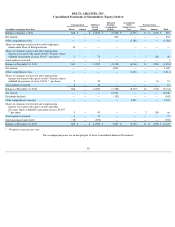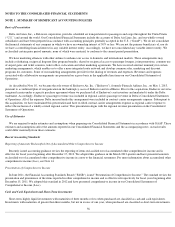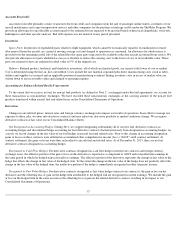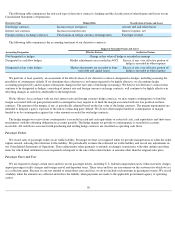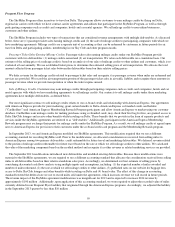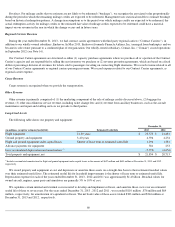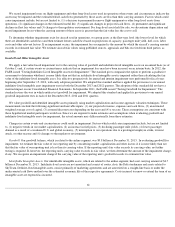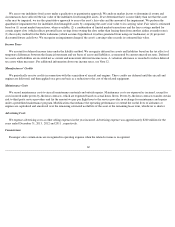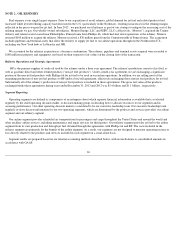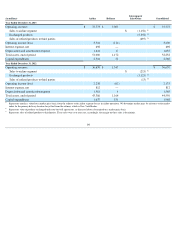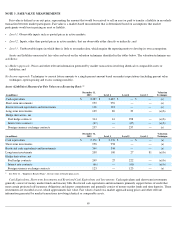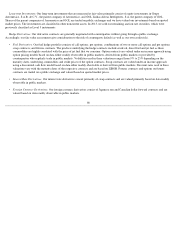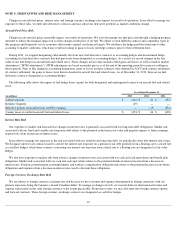Delta Airlines 2013 Annual Report Download - page 65
Download and view the complete annual report
Please find page 65 of the 2013 Delta Airlines annual report below. You can navigate through the pages in the report by either clicking on the pages listed below, or by using the keyword search tool below to find specific information within the annual report.
Accounts Receivable
Accounts receivable primarily consist of amounts due from credit card companies from the sale of passenger airline tickets, customers of our
aircraft maintenance and cargo transportation services and other companies for the purchase of mileage credits under our SkyMiles Program. We
provide an allowance for uncollectible accounts equal to the estimated losses expected to be incurred based on historical chargebacks, write-
offs,
bankruptcies and other specific analyses. Bad debt expense was not material in any period presented.
Inventories
Spare Parts. Inventories of expendable parts related to flight equipment, which cannot be economically repaired, reconditioned or reused
after removal from the aircraft, are carried at moving average cost and charged to operations as consumed. An allowance for obsolescence is
provided over the remaining useful life of the related fleet for spare parts expected to be available at the date aircraft are retired from service. We
also provide allowances for parts identified as excess or obsolete to reduce the carrying costs to the lower of cost or net realizable value. These
parts are assumed to have an estimated residual value of 5% of the original cost.
Refinery. Refined product, feedstock and blendstock inventories, all of which are finished goods, are carried at the lower of cost or market.
Cost is determined using the first-in, first-out method. Costs include the raw material consumed plus direct manufacturing costs (such as labor,
utilities and supplies) as incurred and an applicable portion of manufacturing overhead. Ending inventory costs in excess of market value are
written down to net recoverable values and charged to operating expense.
Accounting for Refinery Related Buy/Sell Agreements
To the extent that we receive jet fuel for non-jet fuel products (as defined in Note 2
) exchanged under buy/sell agreements, we account for
these transactions as non-monetary exchanges. We have recorded these non-monetary exchanges at the carrying amount of the non-
jet fuel
products transferred within aircraft fuel and related taxes on the Consolidated Statements of Operations.
Derivatives
Changes in aircraft fuel prices, interest rates and foreign currency exchange rates impact our results of operations. In an effort to manage our
exposure to these risks, we enter into derivative contracts and may adjust our derivative portfolio as market conditions change. We recognize
derivative contracts at fair value on our Consolidated Balance Sheets.
Not Designated as Accounting Hedges. During 2011, we stopped designating substantially all of our new fuel derivative contracts as
accounting hedges and discontinued hedge accounting for fuel derivative contracts that had previously been designated as accounting hedges.
As
a result, we record changes in the fair value of our fuel hedges in aircraft fuel and related taxes. Prior to this change in accounting designation,
gains or losses on these contracts were deferred in accumulated other comprehensive income (loss) ("AOCI") until contract settlement. At
contract settlement, the gains or losses were then reclassified to aircraft fuel and related taxes. As of December 31, 2013, there are no fuel
derivative contracts designated as accounting hedges.
Designated as Cash Flow Hedges. For derivative contracts designated as cash flow hedges (interest rate contracts and foreign currency
exchange rates), the effective portion of the gain or loss on the derivative is reported as a component of AOCI and reclassified into earnings in
the same period in which the hedged transaction affects earnings. The effective portion of the derivative represents the change in fair value of the
hedge that offsets the change in fair value of the hedged item. To the extent the change in the fair value of the hedge does not perfectly offset the
change in the fair value of the hedged item, the ineffective portion of the hedge is immediately recognized in other (expense) income.
Designated as Fair Value Hedges. For derivative contracts designated as fair value hedges (interest rate contracts), the gain or loss on the
derivative and the offsetting loss or gain on the hedge item attributable to the hedged risk are recognized in current earnings. We include the gain
or loss on the hedged item in the same account as the offsetting loss or gain on the related derivative contract, resulting in no impact to our
Consolidated Statements of Operations.
57


